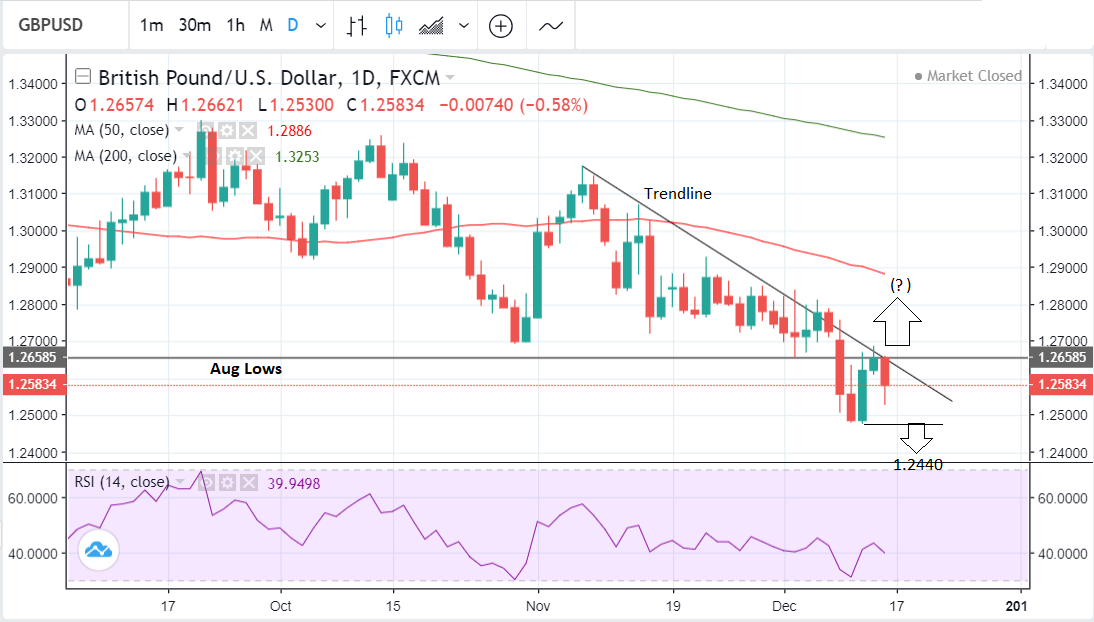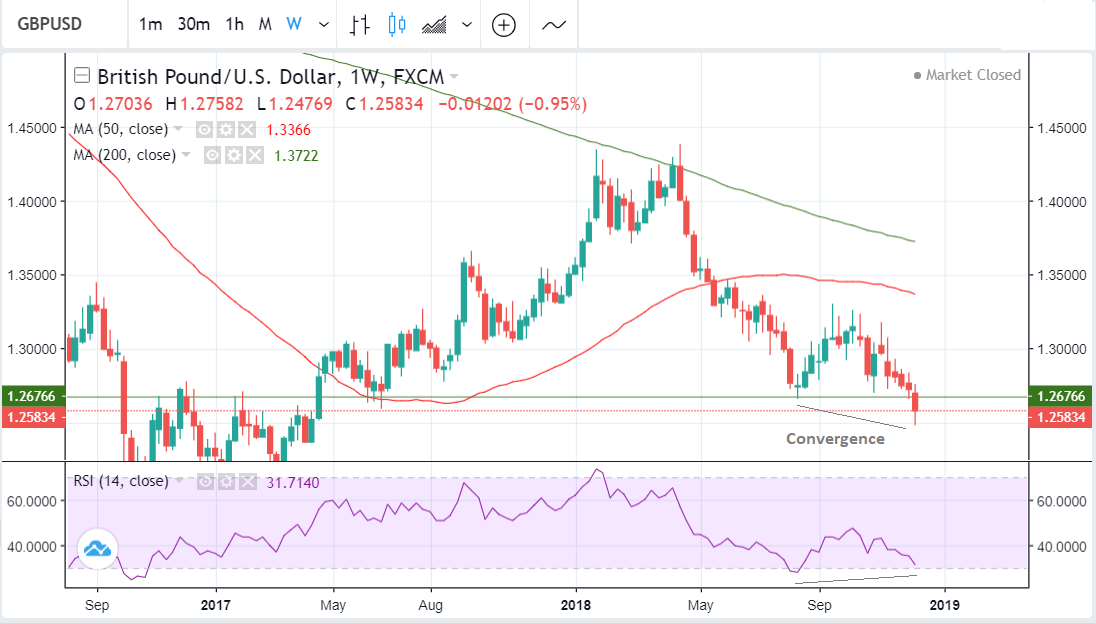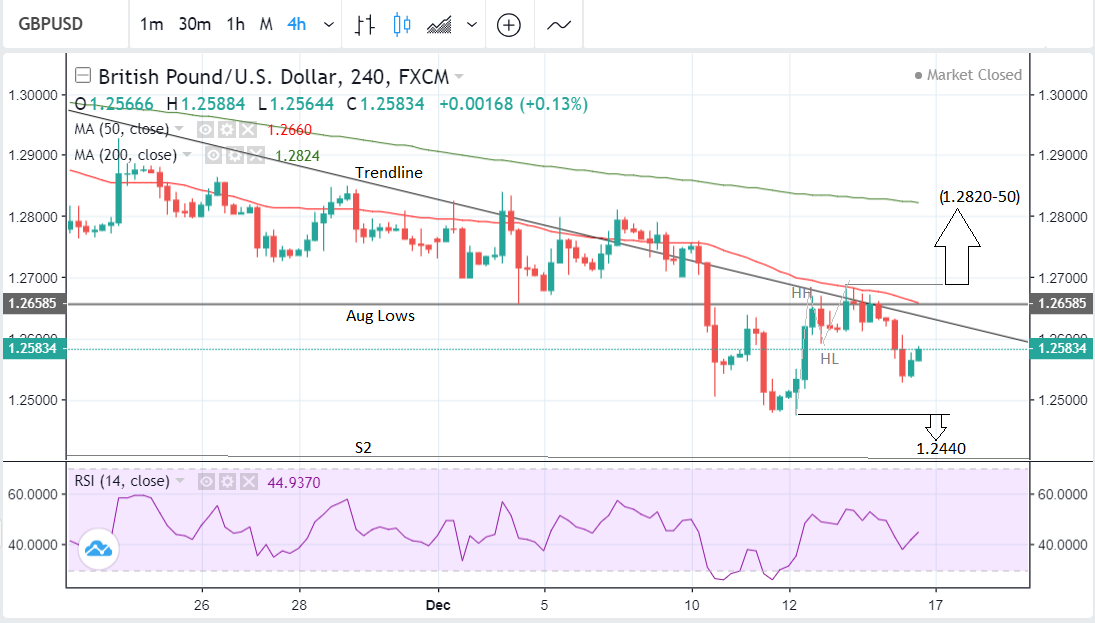The Pound-to-Dollar Rate in the Week Ahead: Downtrend Still Intact

© kasto, Adobe Stock
- GBP bounce not enough to reverse downtrend.
- Break above 1.2687 required to reverse the trend.
- Central bank meetings now in focus for both currencies.
The Pound-to-Dollar rate fell almost a whole percentage point from a week ago after Theresa May's decision to delay the vote on the government's withdrawal deal increased fears of a ‘no-deal’ Brexit materialising, and the bias for the week ahead is toward the downside too.
Despite recovering off recent lows the Pound-to-Dollar pair is currently being constrained by a double layer of resistance at last Friday's highs. This is comprised of of the August lows, which now act as resistance, and a trendline drawn from the November highs.

Above: Pound-to-Dollar rate shown at daily intervals.
This double layer of resistance successfully capped the rate at the end if last week and by remaining intact has kept the downtrend in place too.
Our view is a bearish one, despite conflicting signals from the charts, but we would ideally wish to see confirmation of further downside from a break below the 1.2475 low.
This would signal a continuation down to an initial target at 1.2440 where the S1 monthly pivot is situated and likely to provide support for the market.
Pivots, as their name suggests, are areas where there is an increased chance of a reversal occurring so they present a risk to dominant trends.

Above Pound-to-Dollar rate shown at weekly intervals.
There are some bullish signs that argue for caution. The first is a lack of convergence between the rate and the relative strength index momentum indicator during the formation of the recent low.
This suggests downward momentum was weak during the most recent decline, which could mean the downtrend is waning and that a rebound higher might not be far off.
The 4-hour chart is also giving off some bullish signals as it shows the market flirting with the idea of a possible challenge to the 1.2687 week high. A break above that level would our view of a continued downtrend into question.
A break above 1.2687 would establish a new higher high and signal that a new short-term uptrend is developing and could ultimately give way to a return toward the 1.2820-to-1.2850 area.

Above: Pound-to-Dollar rate shown at 4-hour intervals.
Advertisement
Bank-beating exchange rates. Get up to 5% more foreign exchange by using a specialist provider to get closer to the real market rate and avoid the gaping spreads charged by your bank when providing currency. Learn more here
The US Dollar: What to Watch
The main event for the Dollar in the week ahead is the December meeting of the Federal Reserve (Fed), on Wednesday at 20.00 London time, which is expected to see the Fed raise its interest rates for the fourth time this year.
This will take the Fed funds rate to between 2.25-2.50%, although this move is already priced into exchange rates so markets will focus on the Fed's accompanying statement and latest 'dot plot' instead.
Traders will look to those for clues about high high interest rates are likely to rise next year. Markets are only pricing one full rate hike for 2019 so anything that suggests a similar pace of hikes to that seen this year could lift the Dollar.
“Should the Fed forecast fewer rate increases in 2019 and also lower some of its growth and inflation projections, the US Dollar could come under the firing line in forex markets,” says Broker XM.com.
The personal consumption expenditure (PCE) prices are a key gauge of inflation and the Fed's preferred means to measuring price pressures.
The latest measurement is out on Friday at 14.30, alongside measures of personal spending and income growth. Both of the latter are expected to have risen by 0.3% during November.
Durable goods orders are forecast to have rebounded by 1.7% in November after a -4.4% decline in October. Durable goods orders excluding transportation items are expected to have risen by 0.3% during the period. Both figures will be released alongside the PCE numbers.
Housing data is also scheduled for release on Thursday, which will be important in light of recent economist concerns about a possible slowdown in the market.
The NY empire state and Philadelphia Fed manufacturing stats due at 14: 30 on Monday and Thursday respectively are also both key releases for the U.S.
Advertisement
Bank-beating exchange rates. Get up to 5% more foreign exchange by using a specialist provider to get closer to the real market rate and avoid the gaping spreads charged by your bank when providing currency. Learn more here
The Pound: What to Watch
The main event for the Pound in the week ahead is the Bank of England (BOE) interest rate meeting on Thursday.
Although no change in rates is expected from the BOE, markets scrutinise the BoE's statement for insight into its views on the latest wages data.
UK wages have risen sharply, which is normally a sign that inflation could be rising in a manner likely to draw a response from interest rate setters.
Uncertainty over Brexit will the Bank from raising interest rates for now but markets will want to know the BoE's view on the latest data in order to gauge how soon after Brexit it is likely to take action.
Inflation numbers for November will also be released. Consensus is for the inflation rate to come in at 2.3% for November, down from 2.4% in the previous month. Core inflation is seen at 1.8%, down from 1.9% previously.
Core inflation doesn't include volatile fuel and food items so is seen as a truer reflection of domestically generated inflation pressure.
If the inflation figures surprise on the upside then they could lift the Pound because markets would see them as piling pressure on the BoE to raise rates soon.
The other major release is Gfk consumer confidence index for December, which is forecast to slide to -14, from -13 previously. It has been in negative territory since April 2016.
Retail sales are expected to have risen by 0.3% in November, up from -0.5% previously. Consumer spending and retail sales are significant components of GDP and can impact on the Pound.
Other key releases for Sterling in the week ahead include public sector borrowing for November. The current account balance, business investment and final GDP figures for the third quarter will also be released at the same time.
Brexit news is likely to continue to dominate Sterling's movements, with markets focused on whether the government can win any legally binding concession from the EU regarding the Northern Irish backstop to help the withdrawal deal's passage through parliament in January.
The Pound will probably rally forcefully if concessions are won but could remain moribund into year-end without any. So far the EU has given no concessions but nevertheless, UK negotiators and diplomats are in Brussels all week.
Advertisement
Bank-beating exchange rates. Get up to 5% more foreign exchange by using a specialist provider to get closer to the real market rate and avoid the gaping spreads charged by your bank when providing currency. Learn more here




